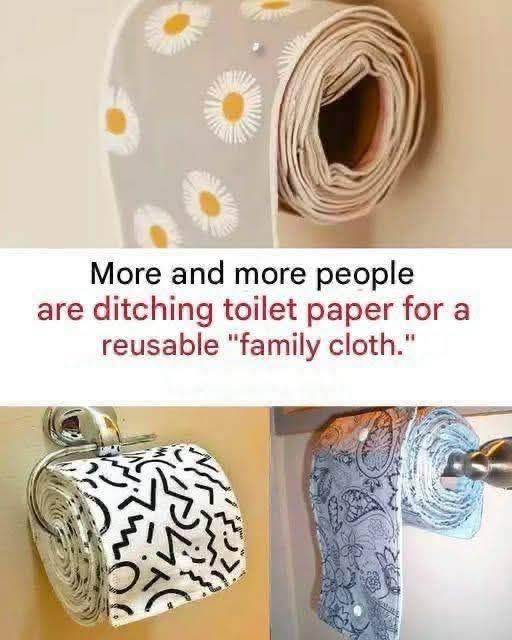Introduction
In a world increasingly focused on sustainability and reducing waste, one surprising household shift is gaining traction: the transition from disposable toilet paper to the reusable “family cloth.” Once considered fringe or even taboo, this eco-friendly option is being embraced by a growing number of environmentally conscious households who are ready to break the norms in pursuit of a cleaner planet—and in many cases, a cleaner bottom!
The idea may sound shocking at first, but when you dig a little deeper, the reasons behind this switch are compelling. From the environmental impact of producing toilet paper to the rising costs of paper products, the “family cloth” is stepping into the spotlight as a zero-waste bathroom solution.
Advertissement
What is a Family Cloth?
A family cloth refers to reusable cloth wipes that replace toilet paper. Typically made from soft, absorbent fabrics like cotton or flannel, these cloths are cut into small squares and rolled or stacked in the bathroom, just like traditional toilet paper. After use, they are placed in a designated container or wet bag, then laundered and reused.
Contrary to what some might believe, family cloths are not shared between people in the literal sense. Each person usually has their own set of cloths, and they’re washed frequently—just like cloth diapers or reusable menstrual products.
Why People Are Making the Switch
1. Environmental Benefits
Toilet paper productioncontributes heavily to deforestation, water waste, and pollution.
A single person uses an average of 100 rolls per year, which adds up to millions of trees.
Family cloths eliminate the constant need for new paper, dramatically cutting household waste.
2. Cost Savings
Toilet paper is a recurring expense, especially for large families.
Reusable cloths are a one-time investment that can save hundreds of dollars annually.
They can be homemade from old towels, flannel sheets, or clothes, making them practically free.
3. Comfort & Hygiene
Many users report that soft cloth wipes are far gentler and more effective than scratchy paper.
Cloths can be used with warm water for a more bidet-like, spa-level clean.
When washed properly, they are very hygienic and odor-free.
Methods for Using and Maintaining a Family Cloth System
Switching to family cloths doesn’t mean sacrificing cleanliness. Here’s how the system typically works:
Supplies You’ll Need:
A set of soft cloth wipes (flannel, cotton, or bamboo are popular choices)
A basket or container to hold clean cloths
A wet bag, lidded bin, or pail for used cloths
Optional: a spray bottle of water or a bidet for pre-wiping
Usage & Washing:
Wipe as usual using a clean cloth (dry or dampened with water).
Place the used cloth in a separate bin or wet bag until laundry day.
Wash every 2–3 days in hot water with your regular detergent. Some people add baking soda or vinegar to the wash for extra freshness.
Dry completely before reusing.
Tip: Families may color-code cloths by person to keep things organized.
Who’s Using Family Cloths?
While still niche, this practice is growing among:
Zero-waste advocates
Homesteaders
Off-grid households
Eco-conscious parents (especially those who already use cloth diapers)
People sensitive to paper products or prone to irritation
During the COVID-19 pandemic, toilet paper shortages also drove many families to try reusable options—and a surprising number stuck with it afterward.
Is It For Everyone?
Not necessarily. Like any lifestyle change, switching to family cloths requires a bit of a mindset shift. Some people may find it inconvenient or uncomfortable. Others may be grossed out by the idea, especially in shared households. However, for those who do make the leap, many say they’ll never go back.
Conclusion
While the thought of reusable “family cloths” might initially make you squirm, it’s a bold and practical solution to some very real problems. From saving money to protecting the environment, this alternative to toilet paper is gaining traction in households willing to rethink the way they do their business.
Ultimately, whether you go full cloth or simply supplement your toilet paper use, every little eco-conscious choice adds up. So if you’re curious, give it a try—you might be surprised by how clean, comfy, and sustainable it really is.
